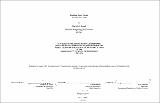| dc.contributor.advisor | Michael Dennis. | en_US |
| dc.contributor.author | Kamell, Elizabeth N. (Elizabeth Natanya) | en_US |
| dc.date.accessioned | 2008-11-07T19:24:28Z | |
| dc.date.available | 2008-11-07T19:24:28Z | |
| dc.date.copyright | 1996 | en_US |
| dc.date.issued | 1996 | en_US |
| dc.identifier.uri | http://hdl.handle.net/1721.1/43285 | |
| dc.description | Thesis (M.S.)--Massachusetts Institute of Technology, Dept. of Architecture, 1996. | en_US |
| dc.description | Includes bibliographical references (leaves 75-76). | en_US |
| dc.description.abstract | Late twentieth-century housing, formed by economic and internally generated functional problems rather than by limitations imposed by traditional street pattern and block size, is fundamentally anti-urban. Modern American housing of the post-World War II era, like any complex social phenomenon, was influenced by multiple forces. Among the most salient are single proprietary control of large parcels of urban land and pre-World War II stylistic trends / social ideals, both of which were reinforced by revisions to zoning regulations. The traditional relationship of the individual dwelling to the block and the street (as well as the individual to the community, as represented by a parallel, formal urban organization) is altered as a result of a changed urban housing configuration. Although the urban characteristics of traditional eighteenth- and nineteenth-century housing blocks remain viable, the dwellings of which they were composed were products of an economic and social structure whose housing requirements are no longer appropriate in contemporary culture. Modem housing, not limited by normative street and block configuration fulfills some of the economic and programmatic requirements of contemporary society, but because it is inherently anti-urban its presence is ultimately destructive of civic life. Analysis of traditional residential urban blocks in terms of quantifiable urban characteristics provides a tool with which to measure and generate programatically modern housing determined by traditional urban constraints. | en_US |
| dc.description.statementofresponsibility | by Elizabeth N. Kamell. | en_US |
| dc.format.extent | 77 leaves | en_US |
| dc.language.iso | eng | en_US |
| dc.publisher | Massachusetts Institute of Technology | en_US |
| dc.rights | M.I.T. theses are protected by
copyright. They may be viewed from this source for any purpose, but
reproduction or distribution in any format is prohibited without written
permission. See provided URL for inquiries about permission. | en_US |
| dc.rights.uri | http://dspace.mit.edu/handle/1721.1/7582 | en_US |
| dc.subject | Architecture | en_US |
| dc.title | Building, block, street : residential block design | en_US |
| dc.type | Thesis | en_US |
| dc.description.degree | M.S. | en_US |
| dc.contributor.department | Massachusetts Institute of Technology. Department of Architecture | |
| dc.identifier.oclc | 36055844 | en_US |
